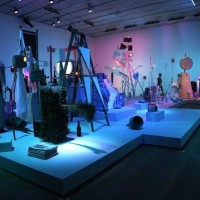Geoffrey Farmer: Let’s Make the Water Turn Black

“Go inside it’s really cool in there.” I had been hesitating outside the wooden door to Let’s Make the Water Turn Black at the Pérez Art Museum Miami (PAMM). My head was already saturated with wall text and neon lights from the other exhibits; and to be quite frank, I was getting hungry. A woman holding a stroller silently moved her head from left to right, indicating that I should enter the installation by Geoffrey Farmer.[1] Disarrayed and intriguingly charming, a post-apocalyptic scene unfurled in front of me as I walked through the door. Lightbulbs of varying colors flicked on and off, shadows bounced in and out of plaster castings, and harsh discordant sounds echoed throughout the mysterious, almost-sinister environment. It was like a night terror I wanted to stay and explore. A cartoonish sculpture of a lion’s head split open and flashing blue light bulbs welcomed me, along with sculptured radios, artificial cacti, and cigarettes strewn about and embedded in gobbledygook objects.

A forensic exposition of Geoffrey Farmer’s work captured in a photograph. Not pictured are: discordant sounds, frenetic lights, and looks of bewilderment. Courtesy Pérez Art Museum Miami.
I paced slowly around the installation, keeping a healthy distance, but compelled forward by unrelenting curiosity. In one corner a slew of white-washed musical instruments dangled in the air, an anthropomorphic wind chime pulled pathetically by fishing line, rose up and down. These musical references echo the title’s namesake: Frank Zappa’s1968 hit, Let’s Make the Water Turn Black. Much like the disjointed, yet melodious cadence of the song, the installation flows in jerky yet meandering ways. Farmer aimed to create a visual homage to Zappa’s sound legacy. The sounds I heard changing and echoing all around were meant to be a sonic time marker, influenced by Musique Concrete[2]. From Sonic Youth to the sonic death of Zappa, sound samples were collected from 1939, the year Zappa was born, to 1993, the year he died.[3] The sounds interplay over the various gramophone-like speakers. Some of the sounds go as far back as the 1850s to the first sound recording.[4] Bits of newsreels, sirens, and classical compositions shift back and forth, and if you are lucky you will catch a sound coincidentally corresponding to the mechanical movement of a prop on stage, or the blinking lights in a severed Brontosaurus’ mouth.
I was struck in particular by the plaster cast man. Supported on ladders, speakers and horns blared music out of his phony corpus. An orange beak has been haphazardly epoxied to his face; his limbs lay in shoddy piles around the figure. The scene consisted of portly plaster thighs, and chalky white feet severed from the ankles. The countenance reminded me of a sort of updated colossus of Constantine or Tim from the local gym. The figure holds a lightbulb dangling in his hands: de-enlightenment imagery in this post-modern playhouse. There was definitely an air of Dada, of the absurd, of surrealism lingering in the piece; Andre Breton’s miasmatic ghost could have been wafting nearby.
Bulbous brown rocks interspersed throughout a white stage served as stopping points, providing the marveling eye a moment of respite from the invisible puppeteer who pulled and thrust levers and mechanisms, animating the lifeless objects. All these found objects which seem arbitrary have a didactic purpose, Farmer explains: “In a way all my work is an education. Here, I’m learning so much about the history of music in North America.”[5] Using Frank Zappa as a reference was a way for Farmer to channel a zeitgeist of 1960s counterculture into a contemporary setting.[6] This fractured sculptural landscape is like a modern day Temple of Zeus, where the deity at worship was a man embedded in the avant-garde of the American psyche.
Suddenly the lights go off, the music stops. This surrealist sanctuary is taking another turn for the eccentric. Cameras, projectors, horns, and a heap of newspapers hailing from Germany are illuminated in an ever changing array of now green, now blue, now red lights. I keep walking around the space. I stop. A chair and a mirror are placed behind two legs. The chair is like a Dali, a Magritte. The visual reality subverts into a dizzying frenzy of sounds and of lights. There is a sign I saw a few items back that read: “NO SMOKING ON THE PLAZA.” Perhaps this is a reference to the cultures of the past, or an era long gone when cigarette smoke filled the air in artistic centers. Farmer’s quivering world is one of absurd aspirations and inhalations.
One might catch themselves “California Dreaming” in a piece like this: palm trees mechanically move up and down, cactuses and amusement-park-like affectations are strewn around. Farmer wanted to convey a sense of Zappa’s own aesthetic: thick with cultural commentary, a rebelliousness of spirit, and a bizarre stance on social standards.[7] Farmer’s piece, though inspired by Frank Zappa, resonates with other exhibitions at PAMM in a playful, engaging manner.
As I’m leaving, a man leans over to me and remarks: “Yeah, that was nice, but I still think Walt Disney did a better job with ‘It’s a Small World After all.’ ”
[1] http://www.redcat.org/exhibition/geoffrey-farmer-lets-make-water-turn-black
[2] http://caseykaplangallery.com/wp/wp-content/uploads/2013/04/farmer_230513_180813_press_docs.pdf
[3] http://www.sleek-mag.com/showroom/2013/06/freak-out/
[4] https://www.youtube.com/watch?v=gWC6QR4W1qk
[5] http://www.sleek-mag.com/showroom/2013/06/freak-out/
[6] https://www.youtube.com/watch?v=gWC6QR4W1qk
[7] https://rockhall.com/inductees/frank-zappa/bio/

